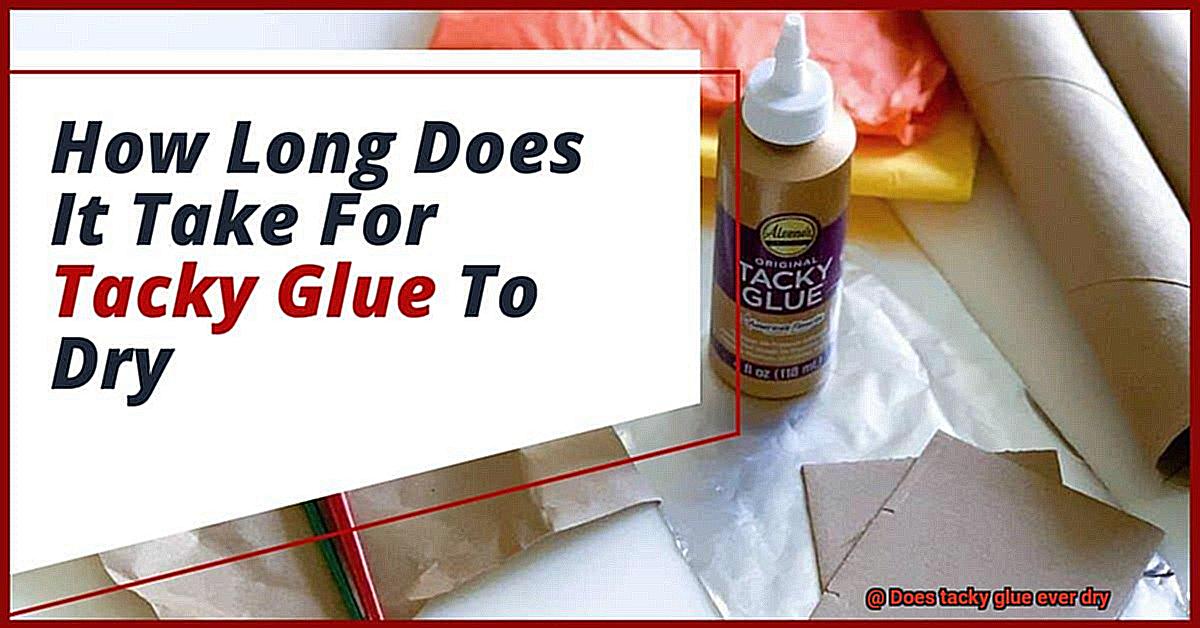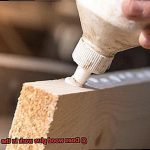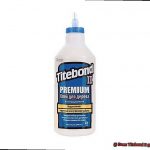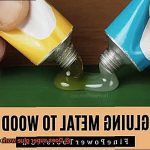Picture this: you’re knee-deep in a crafting frenzy, armed with your trusty tacky glue, and ready to create something magnificent. But as you eagerly stick pieces together, a nagging question lingers in the back of your mind: “Will this glue ever dry?”
Welcome to our journey through the fascinating world of tacky glue, where we’ll unravel the truth behind its drying process. Get comfy and prepare to discover the secrets of this sticky wonder.
Tacky glue is like the superhero of adhesives, known for its incredible sticking power. It’s the go-to choice for all sorts of projects, from DIY masterpieces to school assignments. Unlike regular white glue that dries hard and clear, tacky glue forms a flexible bond that works wonders on fabrics, paper, wood, and even certain plastics.
Now here’s where things get interesting. Tacky glue doesn’t dry in the same way as other glues do. It has its own unique formula that undergoes a mesmerizing transformation during its lifetime. When you first apply it, tacky glue is…well…tacky. It’s semi-dry and slightly sticky, allowing you to make adjustments and reposition things until they’re just right. This special quality sets it apart from other glues and gives you a chance to perfect your craft without losing your mind.
But don’t be fooled – tackiness is not its final form. As time goes by and a magical chemical reaction takes place, the once-tacky consistency morphs into something firm yet flexible. This means your creation will stay put while still being able to withstand all sorts of twists and turns.
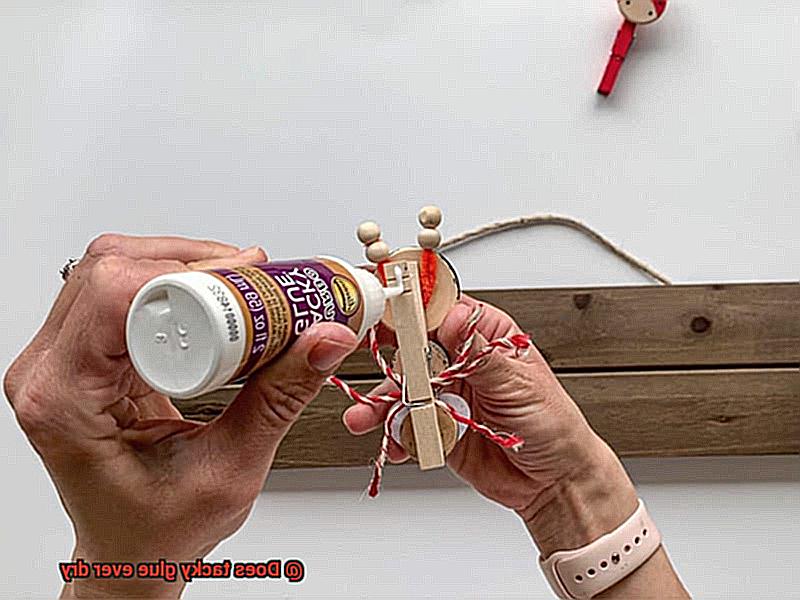
Here’s an important tip: patience is key when working with tacky glue. Unlike those speedy-drying glues that leave you no time to breathe, tacky glue likes to take its sweet time. Depending on the conditions around you, it can take anywhere from a few hours to several days to fully dry. So if you’re in a humid climate or during the chilly months, expect a slightly longer wait. But trust me, it’s worth it.
To speed up the process, make sure your workspace is well-ventilated. Let that fresh air flow and help your glue cure faster. Plus, good airflow prevents any potential issues that may arise from prolonged drying times.
So, there you have it – tacky glue does indeed dry. It just does things its
What is Tacky Glue?
Contents
When it comes to arts and crafts projects, having the right adhesive is crucial. And one adhesive that stands out from the rest is tacky glue. But what exactly is tacky glue, and why is it favored by crafters and DIY enthusiasts? Let’s dive into the world of tacky glue to discover its uses, advantages, and why it should be a staple in your crafting toolbox.
Tacky glue gets its name from its unique tacky or sticky texture, which allows it to adhere to a wide range of materials. Made from a mixture of polyvinyl acetate (PVA) and water, tacky glue forms a strong bond when it dries. Its ability to remain flexible even after drying sets it apart from other types of glue, making it ideal for applications where glued surfaces may experience movement or stress.
Advantages of Tacky Glue:
- Strong Bonding: Tacky glue forms a strong and durable bond that ensures your craft projects last.
- Flexibility: Unlike other glues that become brittle and rigid when they dry, tacky glue retains its flexibility. This makes it ideal for items that may experience movement or stress.
- Quick Drying: Tacky glue dries relatively quickly, allowing you to move on with your project without waiting for hours.
- Non-Toxic: Most brands of tacky glue are safe for use by children and do not emit any harmful fumes. This makes it a popular choice for school projects and crafts involving little ones.
- Versatility: Tacky glue can be used on various materials such as paper, fabric, wood, plastic, and more. Its versatility makes it suitable for a wide range of projects, including scrapbooking, cardmaking, jewelry making, and even household repairs.
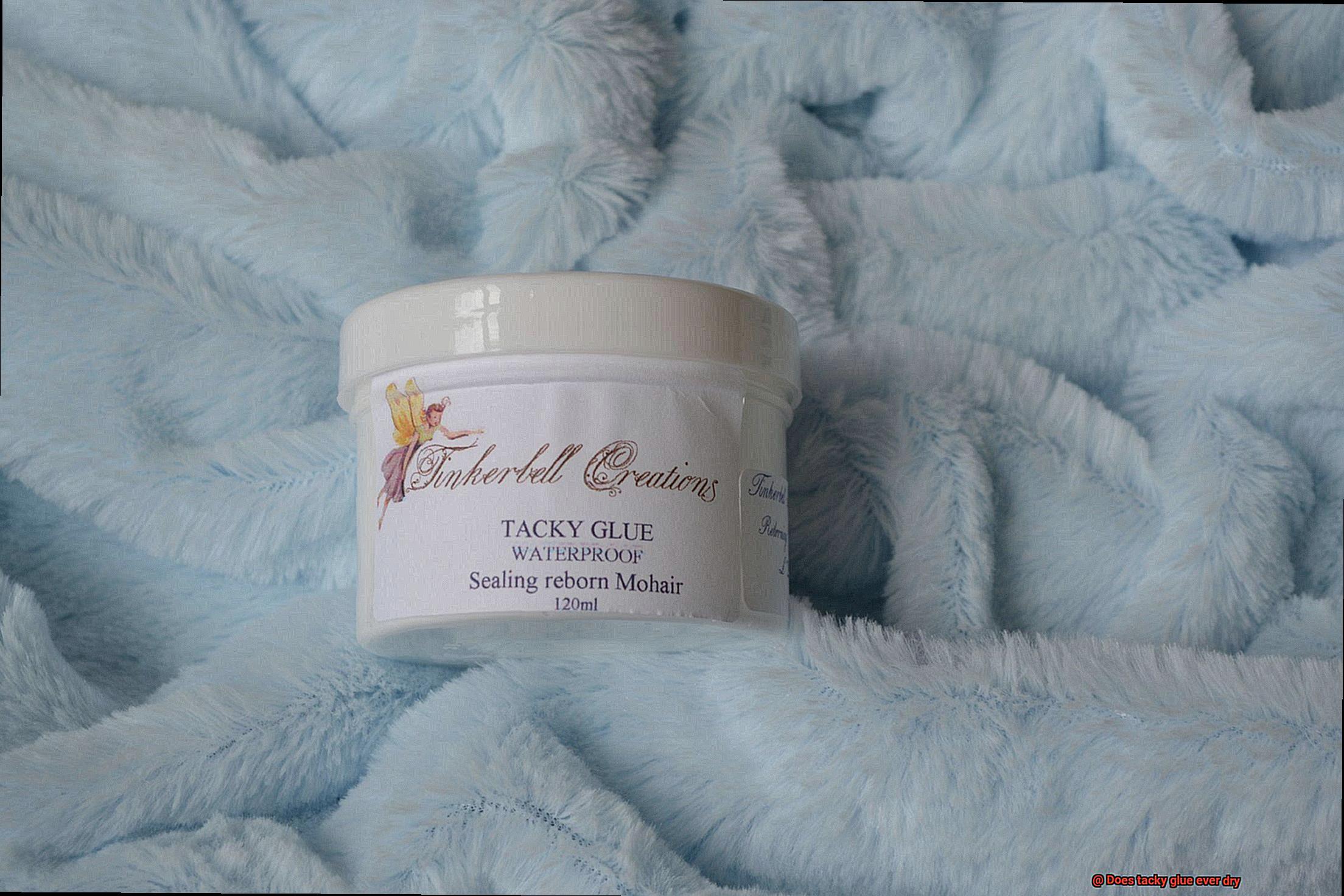
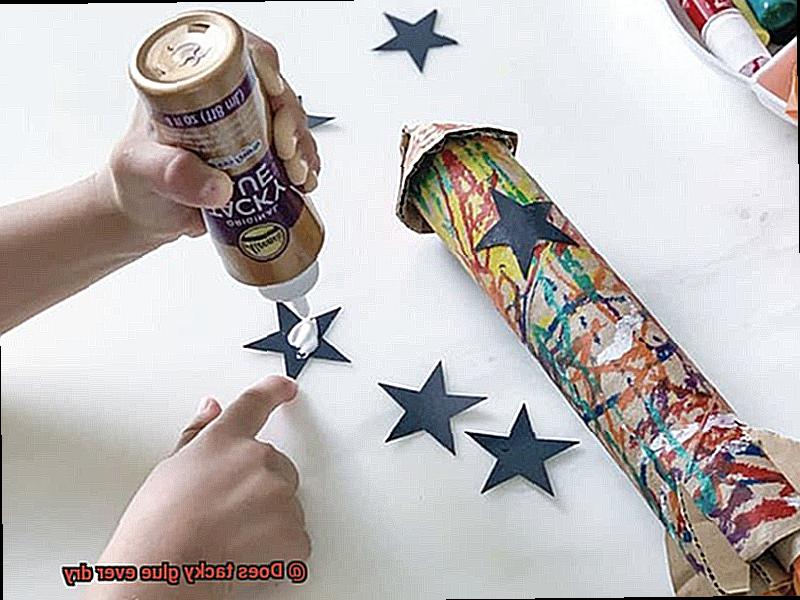
In addition to these benefits, tacky glue is also easy to use. It is generally available in squeeze bottles or tubes, allowing for precise application. The glue is white when wet but dries clear or translucent, making it suitable for use on different surfaces without leaving behind any visible residue.
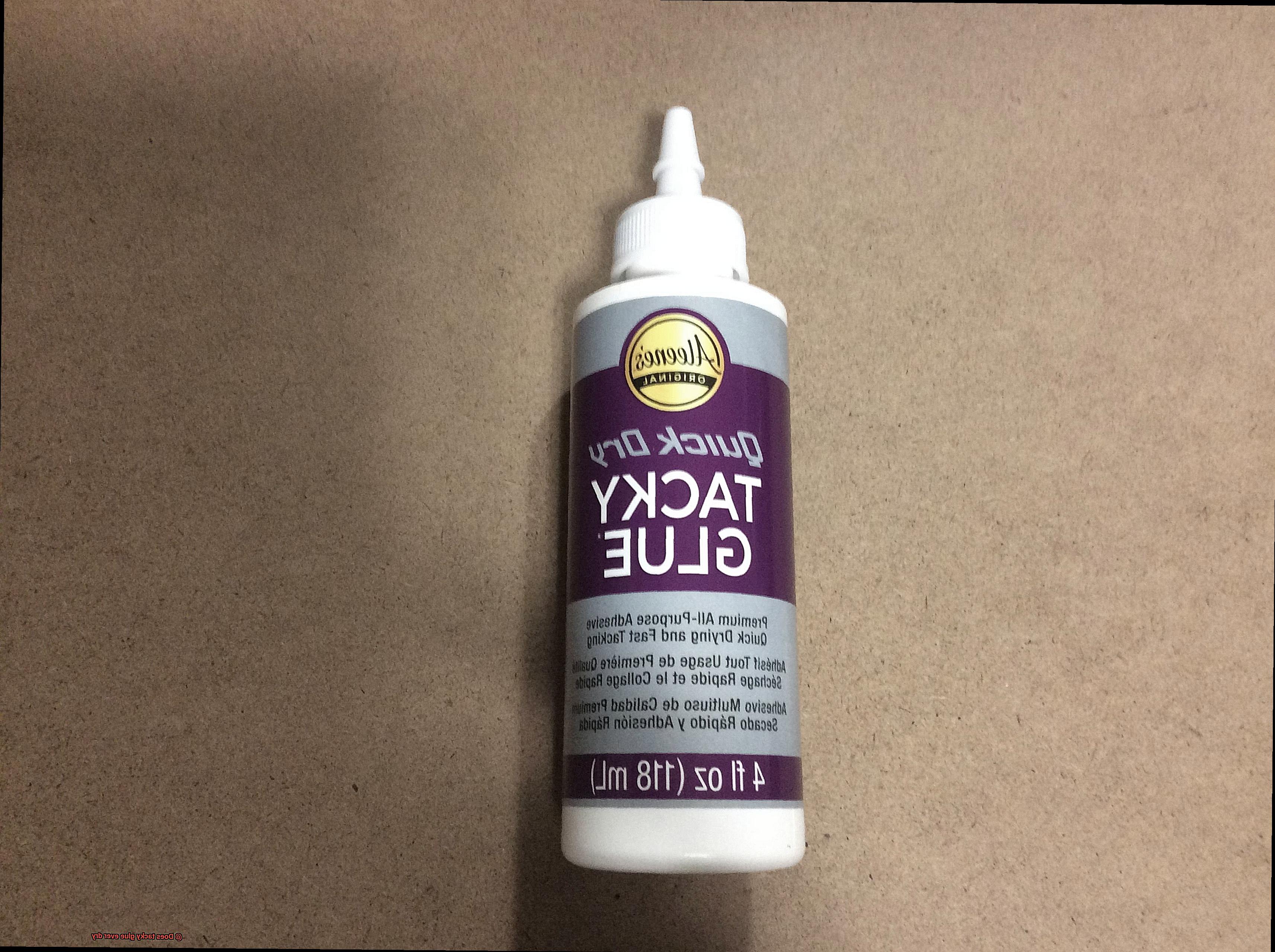
However, it’s important to note that while tacky glue does dry relatively quickly, it may still take some time to fully cure or reach its maximum strength. It is recommended to allow the glued item to dry for at least 24 hours before subjecting it to any stress or pressure.
How Does Tacky Glue Work?
If you’ve ever wondered how tacky glue works its magic, get ready to be amazed. Tacky glue is not your average adhesive – it’s a superhero in the world of bonding. Loved for its quick and secure hold, tacky glue is the go-to choice for arts and crafts projects and household repairs.
So, let’s uncover the science behind tacky glue’s superpowers. This incredible adhesive is made up of a special combination of ingredients, including water, resin, and additives. The resin serves as the main bonding agent, while the water helps to give the glue its viscosity and easy spreading properties.
When you apply tacky glue to a surface, something extraordinary happens. The water in the glue begins to evaporate, causing the adhesive to become thicker and stickier. That’s why it’s called “tacky” – it has just the right amount of grab to cling onto surfaces with ease.
But the magic doesn’t stop there. As the water continues to evaporate, the resin in the glue starts to harden. This process is known as curing or drying. Depending on factors like temperature and humidity, tacky glue typically takes anywhere from a few hours to a day or more to fully dry.
Once tacky glue has dried, it forms an unbreakable bond that can withstand moisture and temperature changes. That’s why it’s perfect for a wide range of applications, from bonding delicate paper and fabric to tough wood and plastic.
Here’s where tacky glue gets even more impressive – it retains some flexibility even after drying. Unlike other glues that become rigid and brittle, tacky glue remains pliable. This flexibility is especially useful for projects that require some movement or adjustment.
But wait, there’s more. Tacky glue has another secret power – it can be reactivated with moisture even after it has dried. So if you need to make adjustments or reposition your glued items, all you have to do is dampen the area with water or use a damp cloth to soften the glue. It’s like having a second chance to perfect your project.
To ensure the best results when using tacky glue, it’s important to follow the manufacturer’s instructions. Apply the glue evenly and give it sufficient drying time before putting any stress on the bonded items. This will ensure maximum adhesion and strength.
While tacky glue is a superhero in the adhesive world, it may not be suitable for all materials. Surfaces that are oily or greasy may not bond well with tacky glue. In these cases, it’s best to reach for a different type of adhesive specifically designed for those materials.
Drying Time of Tacky Glue
Today, we embark on a fascinating journey into the realm of tacky glue, unravelling the mysteries behind its drying time. If you’ve ever found yourself anxiously waiting for your glue to set, fear not. We are about to shed light on this sticky situation.
Let’s start with the basics. Tacky glue, also known as craft glue or PVA glue, is a beloved adhesive used in a plethora of arts and crafts projects. But how long does it take for this magical substance to dry? Well, my friends, that depends on a few factors.
Firstly, let’s talk about the environment. Temperature and humidity take center stage in determining how quickly tacky glue cures. When the mercury rises and humidity levels dip, drying time accelerates. Conversely, chilly temperatures and high humidity can put the brakes on the hardening process. So, if you find yourself crafting in a cozy, arid room, rejoice. Your glue will likely dry faster than if you were working in a frosty and damp space.
Another crucial consideration is the amount of glue applied. A thin layer of tacky glue wins the race when it comes to speedy drying times. Conversely, a thicker application may require more patience. So, if you’re seeking rapid results, go easy on that squeeze bottle.
Remember, appearances can be deceiving. Although your tacky glue may appear dry on the surface within minutes, lurking beneath may be a wet mess waiting to ruin your masterpiece. That’s why it’s crucial to exercise restraint and wait for the full drying time before handling or moving your glued creations. Patience truly is a virtue in this sticky world.
Now, let’s unlock some secrets to hasten the drying process. Should time be of the essence and you yearn for expedited results, you can employ a couple of savvy techniques. A gentle blast from a hairdryer set on low heat or positioning your glued object near a fan can work wonders. However, proceed with caution. Too much heat or airflow can compromise the integrity of the adhesive bond.
And here’s a pro tip for you: different brands and formulations of tacky glue may boast slightly different drying times. To ensure optimal results, always heed the manufacturer’s instructions. They hold the key to unlocking the perfect drying time for your chosen glue.
But what if, despite your best efforts, your tacky glue still feels a little sticky even after it’s fully dried? Fear not. Certain brands and formulations may maintain a slight tackiness. Should this pose a problem for your project, fear not. A clear coat sealant or varnish can come to the rescue, banishing any remnants of stickiness forever.
So there you have it, intrepid crafters – the lowdown on the drying time of tacky glue. Remember to consider temperature, humidity, and the amount of glue applied when estimating the duration of its transformation from gooey to glorious. And if time is not on your side, experiment with these drying hacks.
Advantages of Using Tacky Glue
We delve into the remarkable world of tacky glue and uncover its multitude of advantages. Whether you’re a seasoned crafter or just embarking on your creative journey, tacky glue is an indispensable tool in your crafting arsenal. So grab your glue gun and brace yourself for a sticky adventure.

Versatility:
Tacky glue emerges as the superhero among adhesives, capable of bonding almost any material with remarkable ease. From paper and fabric to wood and metal, this versatile adhesive has got your back. Whether you’re scrapbooking, fashioning jewelry, or creating fabric embellishments, tacky glue will be your steadfast companion throughout your crafting escapades.
Rapid Drying Time:
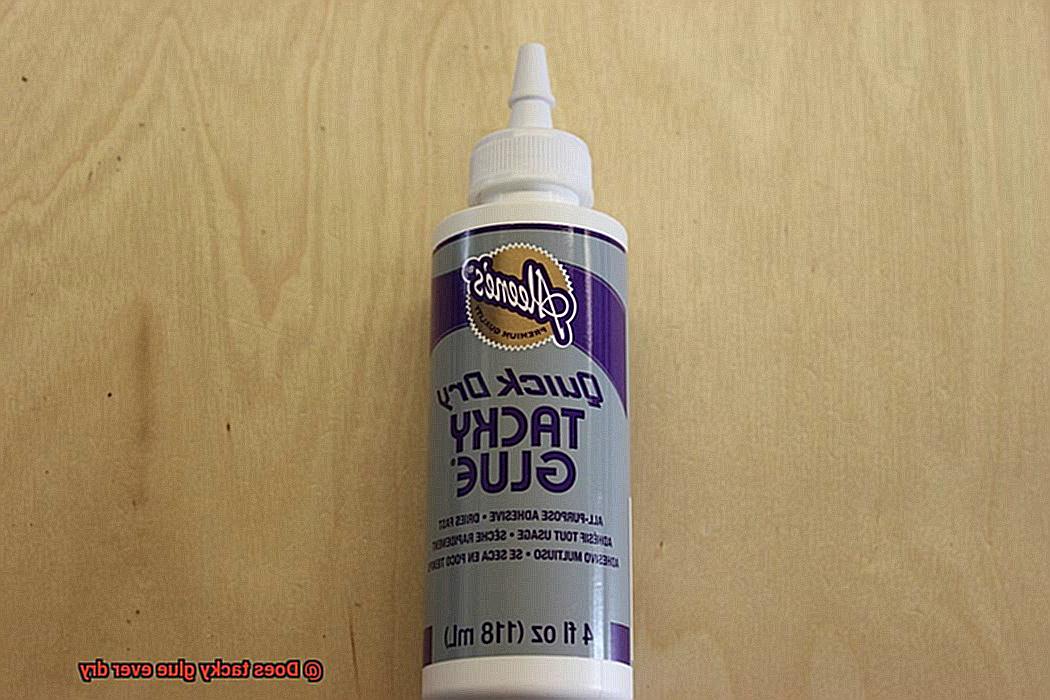
The frustration of waiting hours or even days for glue to dry is now a thing of the past. Enter tacky glue, the knight in shining armor with its lightning-fast drying time. Within mere minutes, your project will be securely bonded and ready to dazzle. This feature proves particularly invaluable when working on time-sensitive projects or when adhering multiple pieces together in a flash.
Formidable Bond:
Bid farewell to feeble connections that crumble under the test of time. Once dried, tacky glue forms an unyielding bond capable of withstanding the rigors of everyday wear and tear. Whether you’re crafting jewelry that endures constant movement or fabric embellishments subjected to repeated washing, tacky glue ensures that everything remains intact.
Mess-Free Application:
Nobody relishes the hassle of dealing with messy glues that drip haphazardly, wreaking havoc on painstakingly crafted work. Fortunately, tacky glue is designed to stay put upon application, enabling precise control over the amount used and averting unwanted spreading. Say goodbye to cumbersome clamps or the need to hold materials together while waiting for glue to dry – convenience at its finest.
Transparent Drying:
Have you ever slaved away on a project only for unsightly traces of glue to mar the final result? Fear not, for tacky glue is here to save the day. This magical adhesive dries transparent, ensuring that your hard work remains visually pristine. Whether you’re engrossed in intricate paper crafts or fashioning delicate fabric designs, tacky glue will preserve the seamless and professional appearance you desire.
Non-Toxic and Safe:
Crafting should be an enjoyable and safe endeavor for all, including our little ones. Hence, tacky glue emerges as an exceptional choice, boasting non-toxic properties suitable for both adults and children. Bid farewell to noxious fumes and hazardous chemicals, and welcome worry-free crafting sessions.
Speeding Up the Drying Process for Tacky Glue
We’ve all been there – stuck in the middle of a crafting project, unable to move forward until that glue is dry. But fear not, my crafty friends. I’m here to share some tips and tricks on how to speed up the drying process for tacky glue. Let’s get those creative juices flowing.
One of the easiest ways to speed up drying is by applying direct heat to the glued area. Grab a hairdryer or heat gun and set it to a low setting. Gently warm up the glue, allowing the heat to evaporate the moisture and accelerate the drying process. Just remember to keep the heat source moving constantly, avoiding any chance of overheating or scorching.
No hairdryer or heat gun? No problem. Increase air circulation around the glued area instead. Position a fan nearby or open some windows to let in a fresh breeze. The moving air will work its magic, helping to remove moisture from the glue more quickly and speeding up drying time.
Applying a thin layer of glue instead of a thick one can also significantly reduce drying time. Thick layers take longer to dry because there is more moisture that needs to evaporate. By opting for a thin layer, you’ll be back to your crafting in no time.
Working with older or thicker glue that’s too viscous? Add a few drops of water to make it easier to spread and help it dry more quickly. Just be mindful not to add too much water, as it can affect the adhesive properties of the glue.
In humid environments, lower humidity levels can do wonders for drying time. Consider using a dehumidifier in the room where the glue is drying. Lower humidity allows moisture in the glue to evaporate faster, resulting in shorter wait times.
And if you’re in need of speed, try using a quick-drying tacky glue formula. These glues are specifically designed for faster drying, allowing for shorter wait times and quicker project completion. Look for labels that mention “quick-drying” or “fast-drying” when purchasing your tacky glue.
Handling and Stress on Dried Tacky Glue
Successfully gluing something together using tacky glue is an accomplishment, but what happens when it comes time to handle and stress the dried bond? In this exploration, we will delve into the effects of handling and stress on dried tacky glue, providing you with valuable insights on how to maintain the bond’s integrity.
First and foremost, let’s discuss the strength of the bond. When tacky glue dries, it forms a robust and resilient connection that can withstand a considerable amount of handling and stress. However, factors such as the type of tacky glue used and the materials being bonded can influence the strength of the bond. Therefore, it is essential to select the appropriate glue for your specific needs.
Now, let’s delve into the proper handling techniques. It is crucial to handle dried tacky glue with care to ensure that the bond remains intact. Forcefully pulling or tugging on the bonded materials can potentially weaken or break the bond. Instead, adopt a gentle approach and delicately handle the glued items.
But what if you need to apply stress to the dried glue? Fear not, for there is a way to do so without causing any damage. If stress must be applied to the bond, do it gradually and evenly. This approach helps distribute the force across the bond, reducing the risk of failure. If additional strength is required, reinforcing the bond with other adhesive methods or materials is a viable option. This can include utilizing extra glue, tape, or other bonding agents to provide additional support.
Temperature and environmental conditions also play a role in maintaining the integrity of dried tacky glue. Extreme heat or cold can affect the bond, so it is best to store and handle glued items in a stable and moderate environment.
In cases where issues arise with dried tacky glue, such as weakened bonds or damage to the glued materials, there are ways to fix it. Repairing or reinforcing the bond can be accomplished by applying more tacky glue or utilizing alternative adhesive methods.
Strength and Durability of Dried Tacky Glue
When it comes to crafting and DIY projects, tacky glue is a popular choice for its strong bond and adhesive properties. But what about the strength and durability of dried tacky glue? Let’s dive into the factors that influence these qualities and learn how to maximize the performance of this versatile adhesive.
Firstly, the quality of the tacky glue itself plays a significant role in its strength and durability. Higher-quality glues tend to have better adhesive properties, resulting in stronger bonds when dried. It’s worth investing in a reputable brand that has been known for its reliable performance.
The surface to which the glue is applied is another crucial factor. Tacky glue adheres well to porous materials like paper, fabric, and certain plastics. However, its bond may not be as strong on non-porous surfaces like glass or metal. If you’re working with non-porous materials, it may be advisable to use a different type of adhesive that is specifically designed for those surfaces.
Furthermore, the conditions to which dried tacky glue is exposed can affect its durability. Excessive moisture can weaken the bond over time, so it’s important to protect your glued creations from water or high humidity. Extreme temperatures can also impact the glue’s performance. If possible, store your projects in a stable environment with moderate temperature and humidity levels.
It’s important to note that while tacky glue has good tensile strength, meaning it can resist being pulled apart, it may not be as strong or durable as other adhesives like epoxy or super glue. If you’re working on a project that requires a higher level of strength and durability, consider using a different adhesive that is better suited for the specific application.
To ensure maximum strength and longevity of dried tacky glue bonds, proper application and drying time are crucial. Follow the manufacturer’s instructions for application techniques and allow ample time for the glue to dry completely. Rushing the drying process can compromise the bond’s strength.
Finishing Touches with Varnish or Sealant
In this guide, we’ll explore the importance of adding a varnish or sealant as the perfect finishing touch. Trust me, your creations will thank you for it.
Why bother with another layer, you ask? Let me tell you why it’s absolutely worth it.
Tacky glue is known for its adhesive strength and flexibility, but it lacks that final touch of a hard finish. That’s where varnish or sealant swoop in to save the day. These magical coatings act as protective barriers against moisture, dirt, and those pesky UV rays. Plus, they give your project a glossy, smooth finish that screams professional craftsmanship.
When it comes to choosing the right varnish or sealant for your tacky glue project, opt for a water-based option. They play nicely with tacky glue and won’t cause any damage or weird discoloration. Say goodbye to sticky or blotchy messes.
Now, timing is everything. Make sure your tacky glue has fully cured before applying the varnish or sealant. Patience is key here; rushing this step can lead to an uneven or sticky finish. Give it around 24 hours for that glue to work its magic.
Prepare your workspace by ensuring it’s clean and free from any dust or debris that might ruin your masterpiece. Grab a clean brush or foam applicator, and apply a thin layer of varnish or sealant evenly across your project. Remember, less is more. Avoid over-applying to prevent drips or a cloudy appearance.
Once the first coat is applied, let it dry completely before deciding if you want to add more coats. Multiple thin coats are your best bet for a flawless finish. For that extra wow factor, lightly sand between coats to smooth out any imperfections.
And now, the moment you’ve been waiting for. After all the coats have dried, your project will be protected from the elements and ready to shine. Moisture, dirt, and UV rays won’t stand a chance against your creation. Display it proudly or use it regularly without worrying about wear and tear.
e7P4KFmgIcM” >
Also Read: How Long Does Super Glue Take to Dry?
Conclusion
Tacky glue, a popular adhesive used for crafts and DIY projects, is known for its strong bond and versatility. However, one common question that arises is whether or not tacky glue ever truly dries. Well, the answer is yes. Tacky glue does indeed dry, but it’s important to understand the unique drying process it undergoes.
Unlike other types of glue that dry through evaporation or chemical reactions, tacky glue dries through a process called “curing”. This means that it goes through a transformation from a liquid state to a solid state over time. During this curing process, the water content in the glue evaporates gradually, allowing the adhesive to become tacky and eventually dry completely.
The duration for tacky glue to fully dry depends on various factors such as temperature, humidity levels, and thickness of application. In ideal conditions with moderate temperatures and low humidity, tacky glue can typically dry within 24 hours. However, if you’re working in an environment with high humidity or applying thicker layers of glue, it may take longer for the adhesive to completely cure.
It’s essential to note that while tacky glue may appear dry on the surface after a few minutes, it’s crucial to allow sufficient time for it to fully cure before subjecting your project to any stress or strain. Prematurely handling or manipulating glued objects can compromise the bond and result in weakened adhesion.
To ensure optimal drying and bonding strength with tacky glue, consider these tips: apply thin layers of adhesive for faster curing time; provide proper ventilation during the drying process; avoid excessive moisture exposure; and be patient – give the glue ample time to cure thoroughly.
In conclusion, rest assured that tacky glue does indeed dry – just not in the traditional sense we may be accustomed to with other glues. Its unique curing process allows for a strong bond once fully dried.

